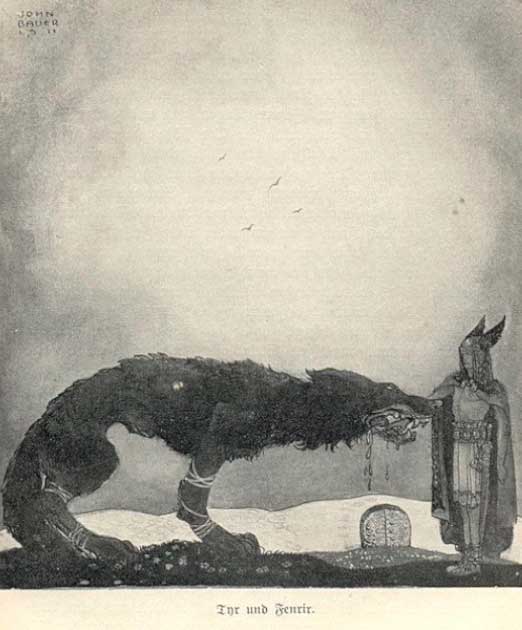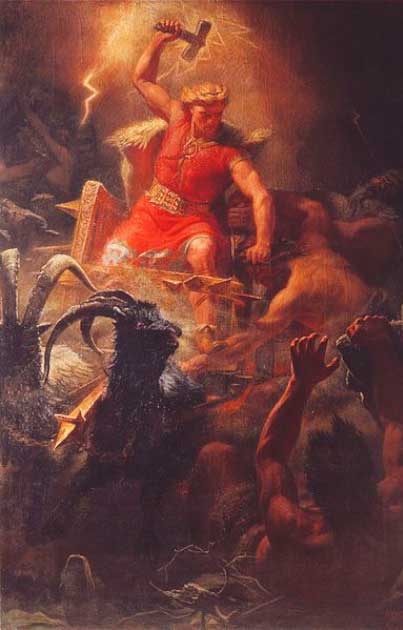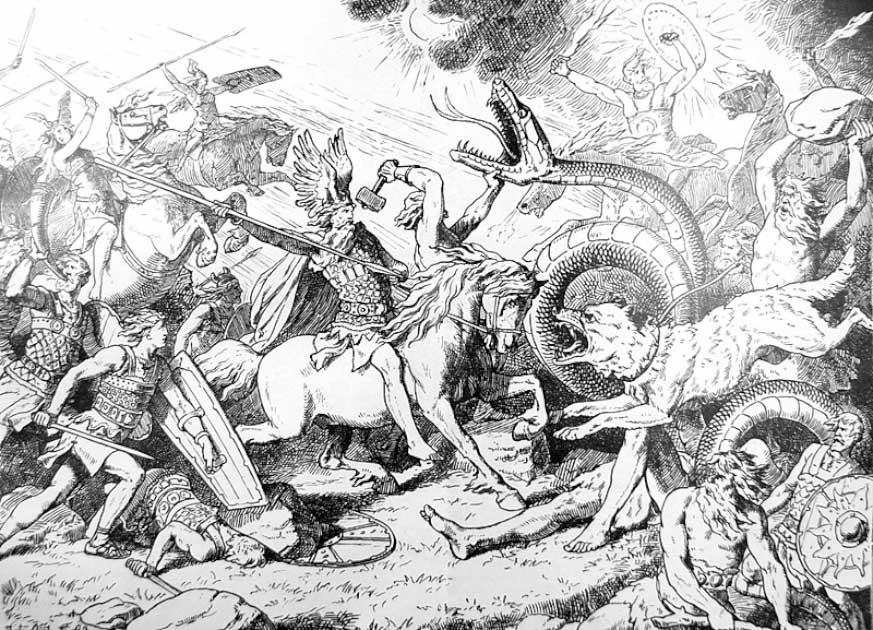Loki is a familiar name to many today, one of the most famous of the Norse gods. Boosted by Marvel’s depiction of the character (you remember: green and yellow, wears horns, annoying) Loki has entered the public consciousness for millions.
But this depiction of the character, a trickster and an egomaniac, is only really one facet of the original Loki. The one whom the Norsemen feared and respected was a far, far weirder individual altogether.
Of all the Norse gods Loki is often portrayed as one of the weirdest, and this of course makes him one of the most interesting gods. Loki appeared in an array of Norse myths, playing friend and foe to its gods.
So, you think you know the real Loki? Here are five reasons why he is stranger than you think.
1. His Son was a Huge Wolf
It is safe to say that Loki had an interesting family life. This ended up with him fathering three sets of children. With his wife, Sigyn (whom we know very little about) he had a son named either Nari or Narf (whom we also know precious little about).
More interesting were the children he had with his mistress, the giantess Angrboda. With her, he sired Hel (the goddess of the underworld), Jormungandr (a giant snake and nemesis of Thor), and Fenrir (a giant wolf). His children all play major roles in Norse mythology.
Hel is the least interesting of the three. Most scholars consider her to be a later Christian addition to Norse mythology. She is the goddess of the underworld and is basically a Christian representation of the idea of Hel, forced into Norse mythology.

Jormungandr was known as the world serpent. Fated to destroy the world, it was thrown into the sea as a baby. Eventually, it grew so large that it coiled itself around the entire world, creating storms and earthquakes as it shifted. Throughout Norse mythology, Jormungandr ends up having several run-ins with Thor, and the two ultimately kill each other.
Fenrir was a giant wolf closely associated with Ragnarok. Early on in Norse mythology, Odin finds out that his fate is to die by the fangs of Fenrir. As such he has the wolf chained up so that it cannot kill him.
It is Odin’s cruel treatment of Fenrir that is in part responsible for Loki’s siding against the gods during Ragnarok. It is also Fenrir who kills Odin during the apocalyptic event, the second of Loki’s children to kill a major god in the Norse pantheon.
2. Not a God? It’s Complicated
There has always been some debate regarding whether Loki was a god. Broadly speaking the two most powerful groups in Norse mythology were the Aesir family of gods and the Jotnar, a race of giants. These two groups had a kind of love-hate relationship. If they weren’t fighting each other, they were making babies.
Typically a union between a Jotnar and an Aesir involved a male Aesir and a female Jotnar. The top god himself, Odin, actually had a Jotnar mother. In Norse mythology, bloodlines run patrilineally (through the father) meaning Odin was still considered a god.
Loki on the other hand was the opposite. His father was Farbauti, a Jotunn, and his mother was Laufey (thought to be a goddess). As such, technically Loki should be classed as a Jotunn. But, this being Norse mythology, nothing is clear-cut.

Viking children’s surnames were usually made by adding a suffix meaning son or daughter to the end of their father’s first name. Loki takes his mother’s name for his surname, Laufeysson (meaning son of Laufey), instead of his father’s. This implies that Loki, at least until the events running up to Ragnarok, saw himself as one of the Aesir.
3. He Was A Talented Shapeshifter
Most people are familiar with the idea of Loki as a magical being. In particular, it is well known that the Loki of Norse mythology was a talented shapeshifter, turning himself into a variety of animals.
In the Sörla þáttr, Loki is tasked with finding evidence that Odin’s lover, Freya, is having an affair. To do this he slips into her chambers by shapeshifting into a flea.
In another tale, The Kidnapping of Idun, Loki must rescue the goddess Idun from a cruel giant, Thiazi. Loki does this by transforming into a giant falcon and flying the goddess to safety in his talons. In other tales, he also takes the form of a fly and a salmon.
The most bizarre of his shapeshifting escapes is perhaps the story in which he becomes a mare. In Gylfaninning Loki transforms himself into a mare to distract Svdilfari, the stallion belonging to a Jotnar the gods were at risk of losing a bet to.
The distraction works and the Aesir win the bet. But it comes at a price for Loki. It turns out he was a little too successful in distracting the stallion and has become pregnant. He eventually gives birth to Sleipnir, who goes on to be Odin’s favorite horse. That’s right, Loki gives birth to a horse in Norse Mythology.
Kinky.
4. He Was a Frenemy to the Gods
Lots of people know Loki as the trickster god. This makes him sound relatively harmless. However, the truth is a little more nuanced than this. Sometimes Loki was a strong ally of the gods, sometimes a dangerous enemy, and very often, a total pain in the…
Firstly there are several occasions where Loki helps the gods. As mentioned earlier, he transformed into a mare in a plot to save Freya from the advances of a giant the Aesir had made a deal with. Furthmore in Þrymskviða, he went out of his way to help retrieve Thor’s stolen warhammer, going as far as to turn himself into a woman to get the hammer back.
Other times Loki was merely a malicious nuisance who delighted in annoying the gods but did little actual harm. A classic example of this is when he cut off all of Sif’s (Thor’s wife) hair while she slept.
When Thor threatened to crush Loki, Loki instantly regretted his decision. He traveled to the home of the master craftsmen, the Black Elves, and had them craft Sif a wig of pure gold. Sif was delighted with her new look.
As time went on though Loki’s actions became increasingly problematic. They hit a boiling point with the death and betrayal of Baldur.
Baldur was the most popular of the Aesir. One day he began having nightmares that foretold his death. Worried that they would come true his mother, Frigg, made all things in existence pledge to never hurt Baldur. There was one holdout, mistletoe. The gods were not worried, seeing as mistletoe was harmless.
Loki had other ideas. He had a spear crafted from mistletoe and tricked Baldur’s blind brother, Hod, into throwing it at Baldur as a joke. The spear struck Baldur in the chest, killing him.
Odin responded by tying Loki to a pile of rocks with the entrails of his son, Nari. Atop Loki was placed a snake that continuously dripped venom into Loki’s eyes, making him writhe in agony.
5. He Played a Major Role in Ragnarok
The death of Baldur led directly to the events of Ragnarok (the Norse Apocalypse, every bit as Viking as you’d expect). The death of their favorite son left the Aesir off-kilter and slow to respond to threats. Odin in particular became increasingly unhinged.

Ragnarok began with Loki escaping from his bonds. His turn to evil was complete and he chose to side with the giants against the Aesir during Ragnarok.
Loki captained the ship that carried the giant army and led them into battle against the gods. Loki’s children joined their father, killing several high-profile gods. During the battle, Loki turned into a seal and battled Heimdall, whom he mortally wounded before being killed himself.
A Deity Like No Other
There is no doubt that Loki is one of the most interesting Norse gods. Throughout Norse mythology, he has a fascinating character arc. Starting as an ally to the Aesir before turning on them and setting into motion their ultimate downfall.
But as these interesting facts show Loki wasn’t always a villain. He was a multifaceted character. While he may have helped destroy the world it is often argued he only did so after years of abuse at the hands of the Aesir. Loki was never really accepted. Not truly an Aesir nor of the Jotnar. His alienation led to the end of the world.
Top Image: Loki is depicted in many different forms throughout the Norse legends and sagas. Source: Haukurth / Public Domain.